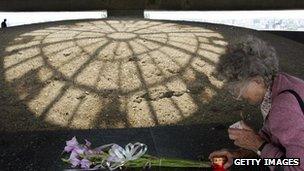Swedish artist uses 'ashes from Holocaust victims'
- Published

The artist said he took the ashes from the camp during a visit in 1989
A painting by a Swedish artist which he says was made with ashes from a former Nazi concentration camp has been displayed in a gallery in Sweden.
Artist Carl Michael von Hausswolff said that he stole the ashes from the Majdanek camp during a visit in 1989.
The camp, now a museum in Poland, has called the alleged theft an "unimaginably barbaric act".
The artist said the ashes were mixed with water and used to paint a series of grey streaks in the small painting.
Museum officials have said that the painting may be an artistic provocation but it deserves only condemnation.
'Repulsive'
An estimated 80,000 people were murdered by the Nazis in Majdanek, three-quarters of them Jews.
The Soviet army discovered the camp in Majdanek in Nazi-occupied Poland in July 1944. It was one of several concentration and death camps built to kill Jews from Poland and elsewhere.
The museum has said it hopes the authorities will quickly establish whether the remains of the camp's victims had been stolen and desecrated and added it was sure the artist did not obtain them legally.
In a text on the Lund gallery's website, the artist is quoted as describing collecting "some ashes from cremation ovens" during a visit to the camp in 1989.
He decided not to use them immediately, he said, because "the material was too heavily loaded with the atrocities that had taken place at the site".
However, he writes that in 2010 he decided to use the ashes mixed with water and describes figures appearing on the page "as if the ash contained energies or memories or 'souls' from people... people tortured, tormented and murdered by other people in one of the 20th Century's most ruthless wars".
Salomon Schulman, a key figure in Sweden's Jewish community, told Swedish television that the art was "repulsive in the extreme", according to news website The Local.
Writing in the Sydsvenskan newspaper, Mr Schulman questioned whether it should be called art.
"Who knows, some of the ashes might come from some of my relatives," he wrote.
- Published19 April 2012
- Published18 October 2010